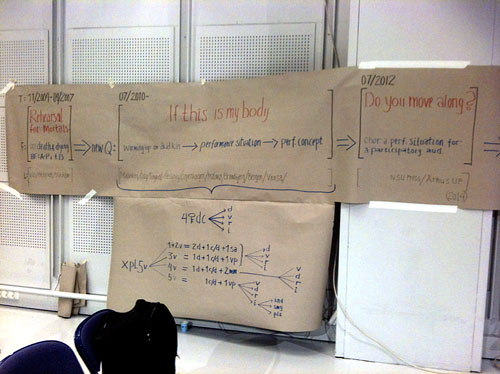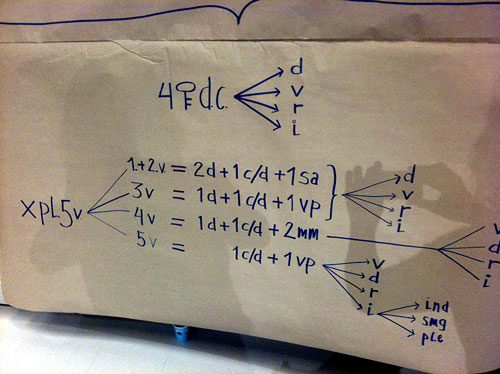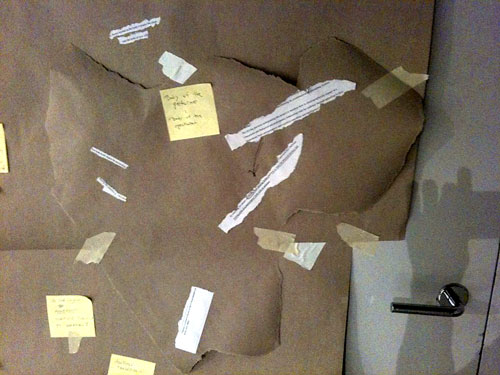Abstract
The presentation discusses the experiences from constructing and developing the performance situation If this is my body. This project results from my doctoral research at Theatre Academy, Helsinki and experiments I have conducted over the last years on “warming up” an “audience” kinaesthetically in order to enhance their proprioceptive sensing. One of the first versions of this project was presented at CARPA in 2011; later versions have been presented, among other places, at the Medical Museion in Copenhagen and at Dramatikkens Hus in Oslo. The presentation reflects on the experiences gained from this artistic research process and questions the traditional divides existing between research, performance and somatic practices.

I have written a paper called “Do you move along? – Choreographing a performance situation for a participatory audience.” The paper discusses the experiences from constructing If this is my body, which is a hybrid between a presentation, lecture demonstration, experimental body workshop and a performance, which I call a performance situation. Conceptually, this performance situation came out of experiments I have conducted since 2010 on “warming up” an “audience” kinaesthetically in order to enhance their sensory awareness. One of the first versions of If this is my body was presented at the previous CARPA in 2011, later versions have been presented, among other places, at Medical Museion in Copenhagen and at Dramatikkens Hus in Oslo. In the paper, I reflect upon the experiences from this artistic research process, which challenges the traditional divides between research, performance and somatic practices.
For this presentation “Viewing and Reviewing a Performance Situation,” I have made a hardware version of a power point in the shape of a paper scroll (of unbleached paper, 1.2 m high, 0,40 m wide when rolled up, 10 m wide when unrolled). When I open it up towards the left, which here means the past, the scroll schematically illustrates how the concept of the performance situation emerged out of questions raised from the process of making the performance A Rehearsal for Mortals (2005) and my doctoral research at Theatre Academy Helsinki. Through my findings and experiences, new questions were aroused that led to the process of making If this is my body.
In the middle of the scroll, which represents the present, I have placed the title of my paper. From this title an arrow points to the right, which here indicates the future, towards yet another question mark followed by a couple of meters with blank paper. This space is set-aside for this session.
As a short explanation, when I prepared for CARPA, I began to question how to present the paper I had written. As a choreographer-researcher presenting a project that explored how to shift the viewpoints and embodied experiences of the audience, I realized that I could not simply read the paper I had written. It would contradict what I was trying to achieve in the project. Instead, I decided on trying to implement in the presentation the thinking embedded in If this is my body – by letting you directly relate to the paper and my writing as a physical object. I hope you will join me in this experiment. The blank space to the right of my scroll is therefore left for your responses, your remaking of it.
(The audience was then divided in four equal groups, one group in each corner of the room. There they found copies of my paper, or rather one quarter of it in each corner. They got five minutes to read individually this quarter of the paper. Then, in groups of three they got 15 minutes to discuss the segment they had read, while cutting or tearing the text apart and placing it on a new sheet of paper, which when the time was up was placed on the blank space on the scroll. In this way, they were taking part in creating the future-past. At last, we had 20 minutes in plenum to discuss the experiences from this intervention and their reading, tearing, and sharing of the paper).
My interest was to try to convey the content of my project that my paper discussed in a performative setting that created what I set out to discuss and report on. I thank all those who attended for taking part in this experiment. The paper is still in a process of being rewritten. It will be published in the anthology Artistic Research: Strategies of Embodiments, edited by Tom McGuirk, Emeline Eudes, and Christine Fenzt, forthcoming 2013/2014 on NSU Press/Århus University Press.


Bio
Per Roar is a choreographer and doctoral student at Theatre Academy, University of the Arts Helsinki. His artistic work combines choreographic exploration with a social-political interest – an approach supported by his diverse educational background, which includes: choreography (Oslo National Academy of the Arts, KHIO), Performance Studies (New York University), and history and social sciences (University of Oslo, Corvinius University Budapest, and Oxford University). Per Roar is a recipient of the National Endowments of the Arts’ Fellowship for Artists (2000–2003) appointed as the first research fellow in choreography at KHIO (2003–2006), and in 2012 awarded the State’s Guarantee Income for Artists in Norway. In his doctoral project he explores a contextual approach to choreography by looking at the phenomena of grieving.